We planted a small patch of aloes in the garden a few years ago. We have enjoyed watching them grow and go on to flower and provide nectar for insects and birds. We have encouraged wild grasses and allowed other self-seeded plants to grow up around them.
There are a few other succulents in the patch and a small group of snake lilies that flower in the springtime. The first aloe to flower in the summer is Aloe cooperi, one of the grass aloes. This aloe occurs naturally in moist grasslands as well as in dry rocky areas, mainly in KwaZulu-Natal, the north-eastern regions of South Africa and in Swaziland.
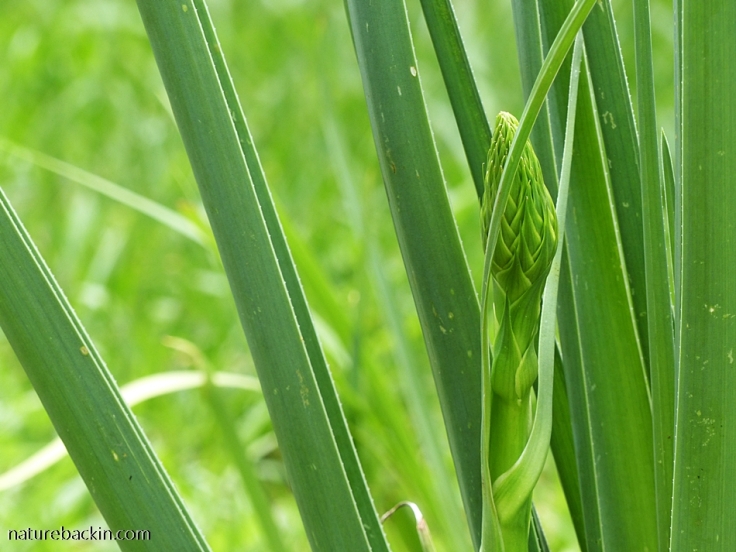
In our aloe patch the bud of the first flower of the Aloe cooperi emerged in December. The flowers and young shoots are cooked as a vegetable in traditional Zulu culture and the plant has been used medicinally to ease childbirth. In rural areas leaves were burnt near cattle kraals as it was thought the smoke would protect cattle from the effects of eating unsuitable food

Like most aloes, the flowers of the Aloe cooperi start opening from the bottom

A close-up of the Aloe cooperi in flower

Aloe cooperi flower head next to an older inflorescence that is going to seed
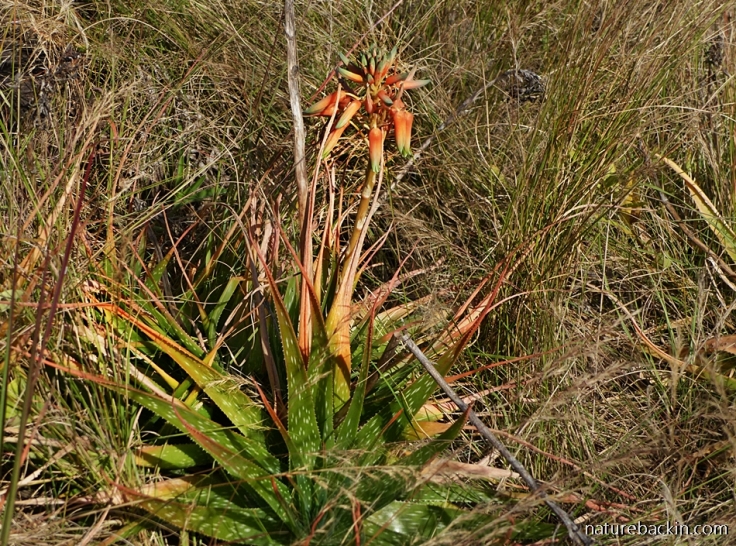
An Aloe cooperi growing wild in grassland in the KwaZulu-Natal Midlands
There are over 500 species of aloe in the genus, with most occurring in Africa, many others in Madagascar, some in the Arabian peninsula and a few species are endemic to islands in the Indian Ocean. In southern Africa about 155 species of aloe occur and different species are found across most habitats.
Being succulents aloes are well adapted to arid conditions, making them a good choice for water-wise gardening. Many species of aloe flower in the winter months when they are an important source of foods for insects, birds and some mammals.

Our aloe patch in September 2017 photographed soon after we had planted the aloes. The largest plant at the back of the patch is a well-established Gasteria

The aloe patch two months later in summer, overlooked by our dog Amy
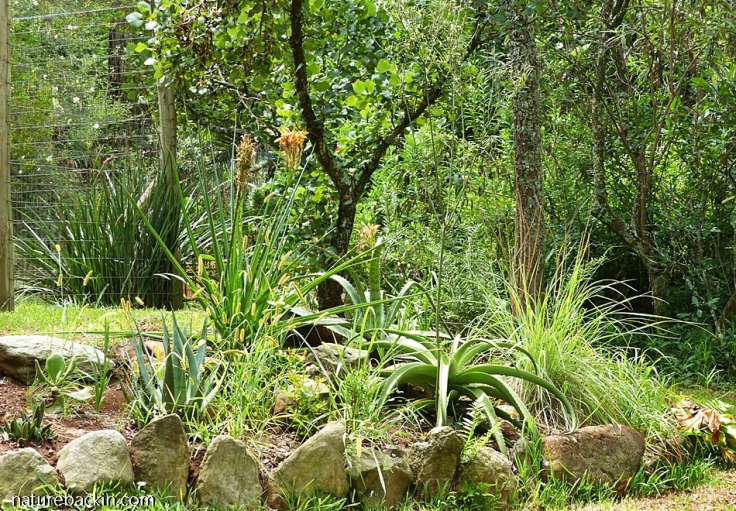
The aloe patch just over two years later in late summer when the flowers of the Aloe cooperi are starting to fade and go to seed
We do have other aloe plants elsewhere in the garden, see for example my post southern-solstice-celebrating-with-aloes. And for a post on aloes in our region growing wild see here: aloe-from-the-other-side
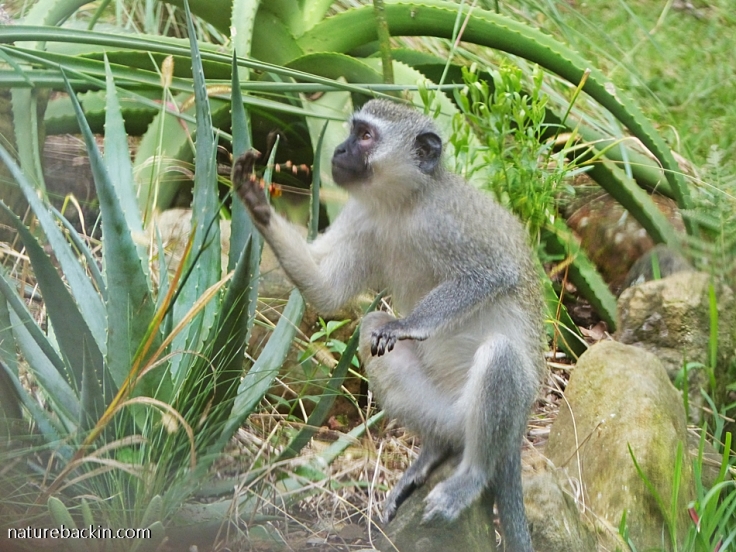
A Vervet monkey in the aloe patch eating crocosmia seeds – photographed while I was peeping through a closed window, hence the blur

A single inflorescence of a winter flowering Aloe vanbalenii is emerging from the centre of its rosette of leaves to reach an ultimate height of about 1 metre. The leaves can be used to make snuff
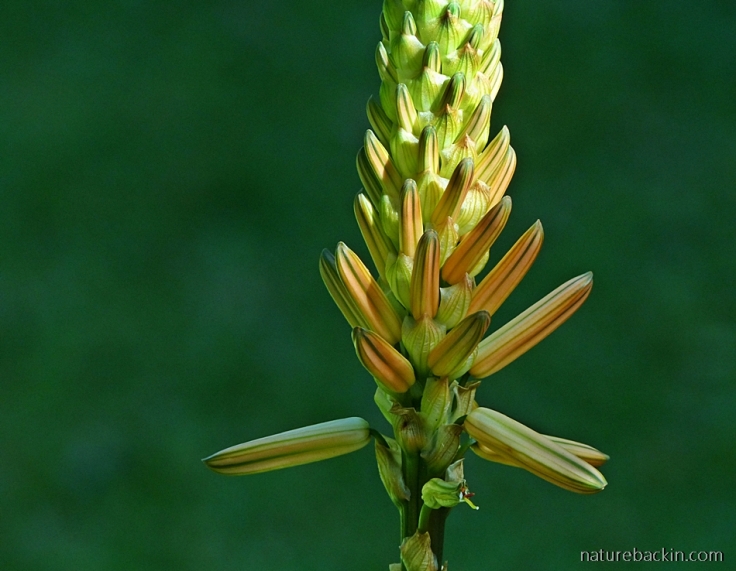
The tubular flowers starting to open on the single inflorescence

As in all aloes, the mature flowers of the Aloe vanbalenii are rich in nectar and pollen

The lower flowers have faded and are starting to go to seed. A bee visits one of the open flowers
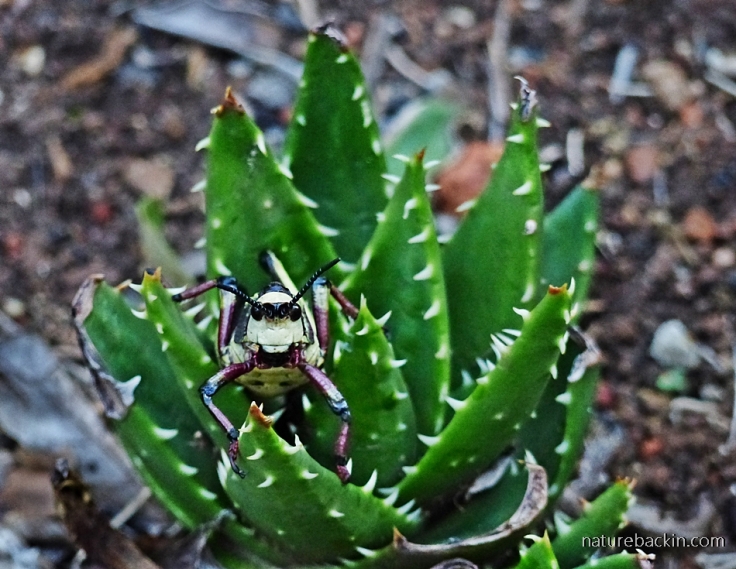
A foam grasshopper settled in a corner of the aloe patch on a small creeping aloe, which is yet to produce any flowers. We bought this tiny Cape species of aloe at a nursery that labelled it Aloe distans. Creeping aloes can be very variable depending on environmental circumstances, and different forms were previously thought to be different species. However, some of these species of creeping aloes, including Aloe distans, are now reclassified as one species: Aloe perfoliata

Aloe chabaudii also flowers in winter. In this photograph the inflorescence is still tightly bunched. It takes several weeks for it to reach its full height when the flowers start to open
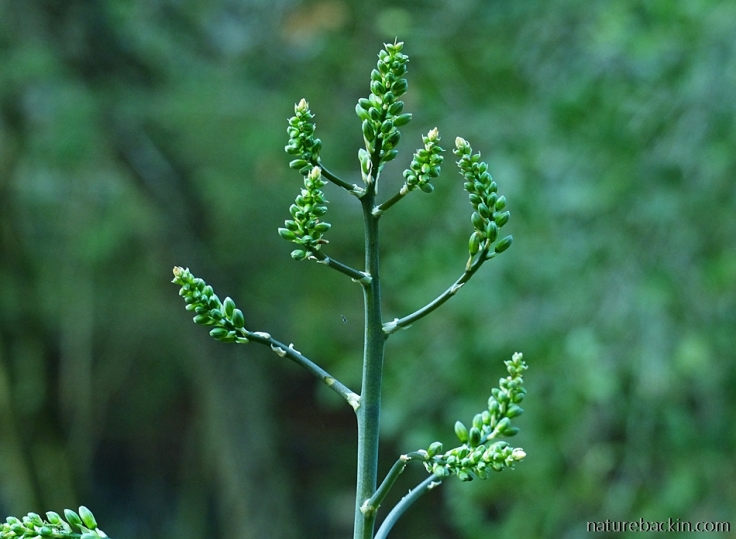
The tall inflorescences are multi-branched. The winter-flowering Aloe chabaudii occurs naturally in north-eastern regions in South Africa and northwards to Tanzania. Parts of the plant are used to make snuff and medicinally for toothache and it is thought to have antimicrobial properties
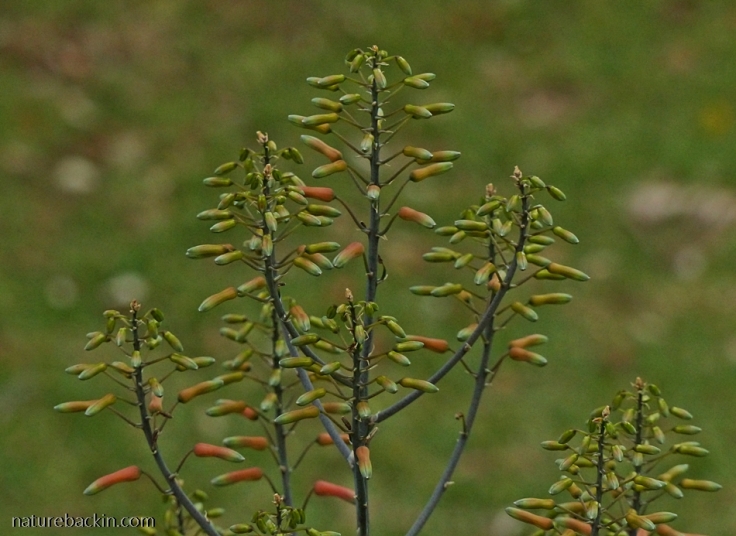
The flowers are starting to open and show their colours

Aloe chabaudii in full flower
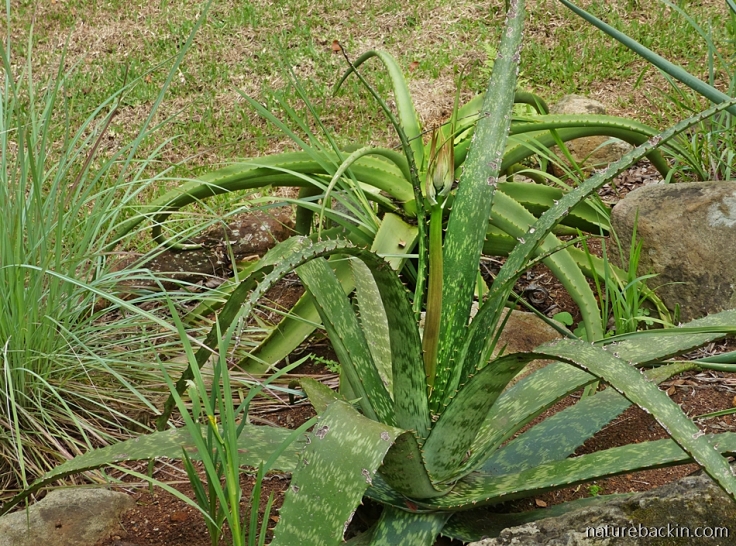
We were pleased to find our local indigenous plant nursery offering a locally endemic aloe for sale. It is the Aloe pruinosa, also known as the Mkondeni aloe

This plant flowers in March each year. It is fascinating to track the slow development of the flowers as the stem slowly extends to a height of about a metre in length

The flowers grow on a tall multi-branched stem. The status of Aloe pruinosa is “vulnerable” as a result of threats that include habitat loss and degradation, displacement by invasive alien species, all specifically as a result of expanding urbanization in its region, and the harvesting of wild plants especially for the medicine trade. Parts of the plant are used in traditional medicine for a variety of purposes

The flowers of Aloe pruinosa are an understated pink with a greyish bloom

Mature flowers decorated with raindrops from the last of the summer rain in March this year

It is now early spring, and tonight as I write this the frogs are serenading in celebration of a soft sprinkle of light rain that we hope is a sign of more to come. The winter flowering aloes are now going to seed and it is a few months before the summer-flowering aloes bloom. In the meantime the sculptural leaves provide striking interest in the aloe patch
Sources:
Klopper, Ronell, R & Smith, Gideon F. 2010. Aloe genus. South African National Biodiversity Institute (SANBI). http://pza.sanbi.org/aloe-genus; Nocwanya, Anelisiwe. 2017. Aloe vanbalenii. PlantZAfrica. South African National Biodiversity Institute (SANBI). http://pza.sanbi.org/aloe-vanbalenii; Mutshinyalo, Thompson T. 2001. Aloe cooperi. PlantZAfrica. South African National Biodiversity Institute (SANBI). http://pza.sanbi.org/aloe-cooperi; Pooley, Elsa. 1998. A Field Guide to Wild Flowers of KwaZulu-Natal and the Eastern Region. Durban: Natal Flora Publications Trust; Victor, J.E. & Dold, A.P. 2009. Aloe perfoliata L. National Assessment: Red List of South African Plants version 2017.1. http://redlist.sanbi.org/species.php?species=2206-200; Victor, J.E. & Scott-Shaw, C.R. 2005. Aloe pruinosa Reynolds. National Assessment: Red List of South African Plants version 2017.1. http://redlist.sanbi.org/species.php?species=2206-215; von Staden, L. 2008. Aloe chabaudii Schönland var. chabaudii. National Assessment: Red List of South African Plants version 2017.1. http://redlist.sanbi.org/species.php?species=2206-45
Posted by Carol






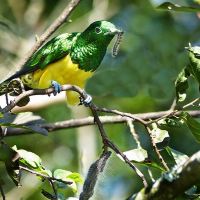
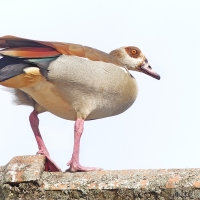

September 4, 2019 at 8:41 am
Loved the stories and pictures, Carol! A friend from here has a son who immigrated to Australia some years ago and started a very successful aloe nursery there. Apparently they are doing very well over there as well….
LikeLiked by 1 person
September 4, 2019 at 12:05 pm
Thanks Suzette. I suppose it is quite surprising that there are no aloes that naturally occur in that part of the world. I can imagine they would do well and be popular in Oz.
LikeLike
September 1, 2019 at 2:36 am
I am sure your aloe garden is as much a delight for the sunbirds as it is for you, Carol. Wonderful to see the plants flowering while still relatively young and small – shows that they too think only the best of your garden!
LikeLiked by 1 person
September 1, 2019 at 6:46 pm
Yes it is nice that they flowered so soon. Oddly the sunbirds prefer the gasteria flowers in that patch and also seem to prefer the Aloe aborescens elsewhere in the garden. Else the visit when we are not looking 🙂
LikeLiked by 1 person
August 31, 2019 at 7:23 am
Glad to see your aloes are doing so well. I have come to appreciate them for more than their leaves – though they are interesting in themselves – but the flowers attract many birds and insects here in Hawaii. There’s a good variety of aloes, especially on the dry western side of the island.
LikeLiked by 1 person
September 1, 2019 at 6:40 pm
I read that many aloes have naturalized in Hawaii (as well as elsewhere in the world).
LikeLiked by 1 person
August 30, 2019 at 1:43 pm
Your aloe patch looks full of interest, Carol; and I just love that grasshopper! Aloes are too exotic for outdoors here of course, although maybe in the warm(ish) SW there may be some which flourish. We certainly have mediterranean plants thriving in Cornwall. And I have a very small aloe grwoing indoors which is doing very well 🙂
LikeLiked by 1 person
August 30, 2019 at 2:34 pm
Thanks Sandra. I suppose the wetness and potential for soggy roots would not suit aloes grown outdoors in the UK, rather than only the colder temperatures as there are mountain species of aloe that can cope with the cold.
As I said in another comment, the intriguing grasshopper is very toxic – it exudes a toxic foam when threatened. Many foam grasshoppers have bright colours perhaps associated with their toxicity. Fortunately most dogs know to leave them alone, but unfortunately the poison is fatal to dogs (and other animals) should they bite one of these grasshoppers.
LikeLiked by 1 person
August 30, 2019 at 2:59 pm
Oh my gosh, it certainly sounds a fearsome creature! Now I understand it’s name too. I shall revise my original comment to ‘I love the photograph’! As a photo, it’s stunning!
LikeLiked by 1 person
September 1, 2019 at 6:34 pm
Thanks Sandra. In a way its paradoxical that its toxicity “allows” it to look so remarkable!
LikeLiked by 1 person
August 30, 2019 at 8:39 am
Wow such beautiful arrays of flowers, Carol. Loved all the pictures, beauty at its most best.
LikeLiked by 1 person
August 30, 2019 at 1:51 pm
Thank you very much Kamal.
LikeLike
August 30, 2019 at 2:27 pm
Welcome 😊😊 😊
LikeLiked by 1 person
August 30, 2019 at 5:44 am
Few posts have made your garden seem more exotic to me than this one. Aloes are definitely not on any British gardener’s planting menu. And thanks for the tour of the wildlife that benefit from your planting choices!
LikeLiked by 1 person
August 30, 2019 at 1:48 pm
I am often amazed at the SA plants that do flourish in the UK, but I guess it is unsurprising that aloes are not among them 🙂
LikeLiked by 1 person
August 30, 2019 at 2:50 pm
I don’t think I’ve ever seen one in a domestic garden.
LikeLiked by 1 person
August 29, 2019 at 7:59 pm
How charming that our lizards were singing last night in rapture of the trace of moisture we were graced with yesterday. Their serenade has become very dear to me! How odd and thrilling to think that our reptiles might have been doing a duet from opposite sides of the planet! 😀
I have to confess to some aloe envy. I try to nurture an aloe plant indoors and it struggles to hang on, much less flower. I’ve never seen one actually flower around here. I had some aloe plants (still indoors) that did better in previous houses where the light must have been more to their liking. Funny how every time I move (and lord knows that’s happened all too often!), I have to move plants around to different locations to find any that suit them.
I did give into an impulse to try planting an agave on the front bank where there’s lots of sun in summer after seeing a huge one in someone’s yard here. It was looking rather sickly through our wet winter, but seems to have regained some of its color during these past months. I thought of making an umbrella for it! 😉
Your foam grasshopper looks like a child’s toy! How very unique. And I’m happy to see your charming Vervet monkey, as always.
LikeLiked by 1 person
August 30, 2019 at 2:15 pm
I had not heard of serenading lizards before, The closest thing to that I am aware of are the barking geckos that call at dusk in some of our arid regions. Glad to know that you have had some rain.
I have never really thought of aloes as indoor plants other than the Aloe vera grown for the medicinal properties of its leaves. I think because of our mild winters in SA we have a different relationship with indoor plants.
I am sorry to say that the toy-like foam grasshopper is extremely toxic – but only if eaten of course. I am pleased that you like our Vervets, especially as they are commonly disliked and persecuted here.
LikeLiked by 1 person
August 29, 2019 at 5:25 pm
The Eastern Cape veld is awash with aloes at the moment.
LikeLiked by 1 person
August 30, 2019 at 1:12 pm
The Eastern Cape is fabulous for aloes. It is fortunate that they can cope with the aridity and ongoing drought, at least up to a point. Here the flowering season is pretty much over.
LikeLike
August 31, 2019 at 12:44 pm
The red fields of flowers I saw were alongside the N10 near Cookhouse. I think they are Aloe Striata
LikeLiked by 1 person
September 1, 2019 at 6:44 pm
Oh how nice as I think they are quite showy when flowering. Someone gave us an A. striata as a gift and we have planted it out and await to see how it will do here. It is interesting that the leaves have no thorns.
LikeLike
August 29, 2019 at 4:45 pm
Such a valuable, drought-tolerant plant that has been adopted all over the world. Our dry Southwest uses them widely. Attractive foliage and long-lasting flowers, some are so pretty!
LikeLiked by 1 person
August 30, 2019 at 1:07 pm
I forgot to mention that some aloes have even naturalised in other parts of the world. It is interesting that they have been adopted in so many other countries and continents,
LikeLiked by 1 person
August 29, 2019 at 4:05 pm
Am loving your aloe patch, Carol. Really beautiful.
LikeLiked by 1 person
August 30, 2019 at 1:04 pm
Thanks Tish. It’s been interesting watching them grow up!
LikeLiked by 1 person
August 29, 2019 at 3:35 pm
I sawa snake today so I guess Winter is on the wane.
John
LikeLiked by 1 person
August 30, 2019 at 1:03 pm
Maaaybe 🙂 Bit of a change again today!
LikeLike
August 29, 2019 at 3:15 pm
Such a variety of forms and colors, Carol. Beautiful!
LikeLiked by 1 person
August 30, 2019 at 1:02 pm
Thanks Sandy. Yes aloes are amazingly diverse.
LikeLiked by 1 person